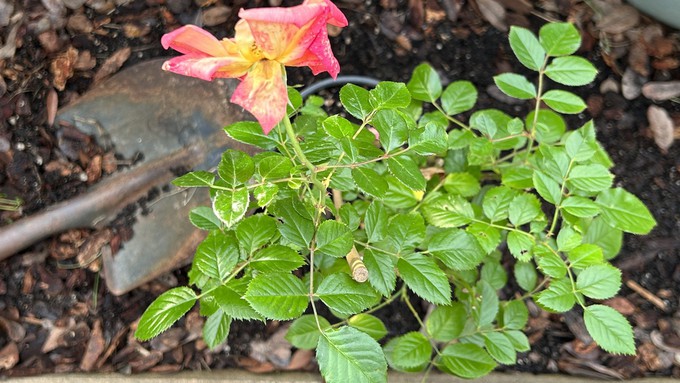
Rose society offers advice on transplanting -- and digging up – rose bushes

Got a rose that needs to be planted, but you're out of space? Learn the options during the Sacramento Rose Society's next meeting Thursday, Jan. 11. (This is a Polynesian Punch floribunda rose, and yes, it needs a permanent space to grow.) Kathy Morrison
There comes a time in every rose gardener’s life: Where are you going to plant another bush?
Often, the answer may be: Take one out.
It’s called “shovel pruning” – the hard choice to dig up a bush that, no matter your efforts, just isn’t performing as expected.
Or maybe this problematic bush is just in the wrong place. Then it needs one more chance – in a better location. How do you transplant a bush that’s already been growing in the ground?
For that matter, what’s the best way to transplant any rose bush – from those that come packed in plastic to others rooted in a supposedly biodegradable pot?
Here’s your chance to find out! Our rosarians will tackle transplanting, shovel pruning and other timely tasks during the January meeting of the Sacramento Rose Society. Moderator Debbie Arrington, a master rosarian and co-creator of Sacramento Digs Gardening, will lead a panel discussion on the different ways to approach these jobs.
January is the best month to transplant roses in our area. The soil is soft from rain, yet still warm enough for root development. Put in the ground now, these new bushes will likely produce roses this spring.
The meeting will be held at 7:30 p.m. Thursday, Jan. 11, at Shepard Garden and Arts Center, 3330 McKinley Blvd., Sacramento, in McKinley Park. Parking and admission are free.
As always, rose society meetings are open to the public. Bring a friend!
Want advice about pruning, fertilization and other aspects of winter rose care? Check out the Winter Rose Care Workshop, hosted by the Sierra Foothills Rose Society. To be held at the Orangevale Grange Auditorium, this free public event will be held Saturday, Jan. 13, starting with registration at 8:30 a.m. and ending with a lunchtime chili cookoff.
Learn more here: https://sacdigsgardening.californialocal.com/article/80414-sierra-foothills-rose-class-2024/.
Comments
0 comments have been posted.Sacramento Digs Gardening to your inbox.
Food in My Back Yard Series
May 6: Maintain soil moisture with mulch for garden success
April 29: What's (already) wrong with my tomato plants?
April 22: Should you stock up on fertilizer? (Yes!)
April 15: Grow culinary herbs in containers
April 8: When to plant summer vegetables
April 1: Don't be fooled by these garden myths
March 25: Fertilizer tips: How to 'feed' your vegetables for healthy growth
March 18: Time to give vegetable seedlings some more space
March 11: Ways to win the fight against weeds
March 4: Potatoes from the garden
Feb. 25: Plant a fruit tree now -- for later
Feb. 18: How to squeeze more food into less space
Feb. 11: When to plant? Consider staggering your transplants
Feb. 4: Starting in seed starting
Sites We Like
Garden Checklist for week of May 11
Make the most of the lower temperatures early in the week. We’ll be back in the 80s by Thursday.
* Plant, plant, plant! It’s prime planting season in the Sacramento area. Time to set out those tomato transplants along with peppers and eggplants. Pinch off any flowers on new transplants to make them concentrate on establishing roots instead of setting premature fruit.
* Direct-seed melons, cucumbers, summer squash, corn, radishes, pumpkins and annual herbs such as basil.
* Harvest cabbage, lettuce, peas and green onions.
* In the flower garden, direct-seed sunflowers, cosmos, salvia, zinnias, marigolds, celosia and asters. (You also can transplant seedlings for many of the same flowers.)
* Plant dahlia tubers.
* Transplant petunias, marigolds and perennial flowers such as astilbe, columbine, coneflowers, coreopsis, dahlias, rudbeckia and verbena.
* Keep an eye out for slugs, snails, earwigs and aphids that want to dine on tender new growth.
* Feed summer bloomers with a balanced fertilizer.
* For continued bloom, cut off spent flowers on roses as well as other flowering plants.
* Add mulch to the garden to maintain moisture. Mulch also cuts down on weeds. But don’t let it mound around the stems or trunks of trees or shrubs. Leave about a 6-inch-to-1-foot circle to avoid crown rot or other problems.
* Remember to weed! Pull those nasties before they set seed.
* Water early in the day and keep seedlings evenly moist.